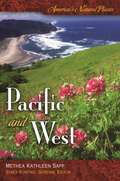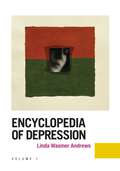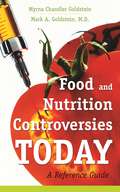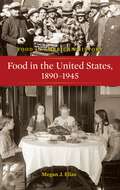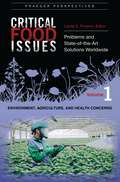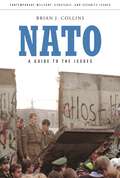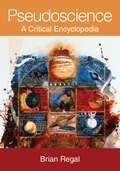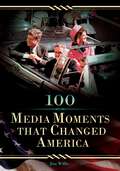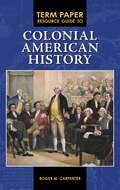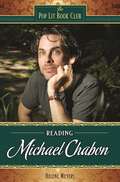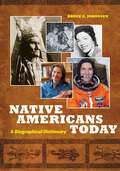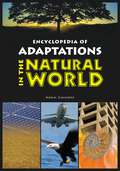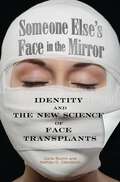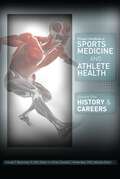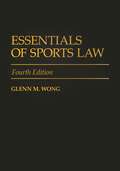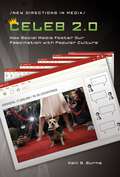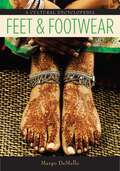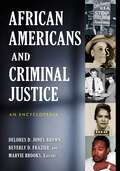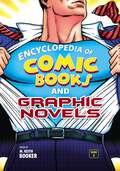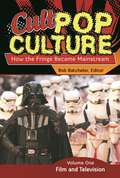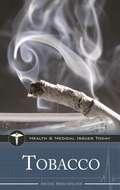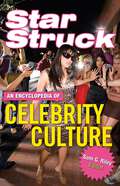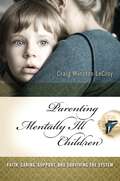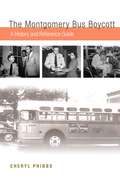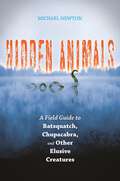- Table View
- List View
America's Natural Places: Pacific and West (America's Natural Places)
by Methea K. SappFrom Alaska's Arctic National Wildlife Refuge to the Milnesand Prairie Preserve of New Mexico, this volume provides a snapshot of the most spectacular and important natural places in the western United States.America's Natural Places: Pacific and West examines over 50 of the most spectacular and important areas of this region, with each entry describing the importance of the area, the flora and fauna that it supports, threats to the survival of the region, and what is being done to protect it. Organized by state within the volume, this work informs readers about the wide variety of natural areas across the western part of the United States and identifies places that may be near them that demonstrate the importance of preserving such regions.
Encyclopedia of Depression [2 volumes]: [2 volumes]
by Linda Wasmer AndrewsWritten in clear, nontechnical language, and filled with lively historical and cultural highlights, this comprehensive reference work is a scientifically grounded yet thoroughly readable introduction to depressive disorders.What distinguishes normal everyday emotional swings from debilitating, clinically identified depression? What are the defining symptoms, manifestations, and treatments? What is life like for people suffering from depression and for those who care for them? The Encyclopedia of Depression is for all those needing answers to questions like these—individuals, families, health professionals, or anyone fascinated by this pervasive condition.Written in clear, nontechnical language and highlighting fascinating historical and cultural perspectives on the topic, this two-volume resource presents a complete contemporary portrait of depressive disorders, summarizing the latest scientific, medical, and societal thinking on a wide variety of depression-related topics. Coverage includes causes, risk factors, symptoms, diagnosis and prevention, and a wide range of treatment options, including psychotherapy, medication, biological treatments, alternative therapies and lifestyle approaches. In addition, the encyclopedia discusses historical and cross cultural perspectives on the condition, including the dramatic shifts in public awareness and cultural attitudes toward the disease and the devastation it can cause.
Food and Nutrition Controversies Today: A Reference Guide
by Myrna Chandler Goldstein Mark A. MDIs any food safe? Will mad cow disease kill us all? How many calories are really in your restaurant Caesar salad? Modern consumers are besieged with conflicting messages about food and nutrition, making it difficult for the lay person to know what to believe. This no-nonsense resource explores the latest controversies in the field of food and nutrition, presenting readers with the varying opinions and underlying facts that fuel these debates. Fifteen chapters focus on hot topics like organic food, bottled water, and deadly bacterial outbreaks as well as lesser known issues such as food irradiation, vitamin supplementation, animal growth hormones, and more.One of the few resources of its kind, this informative reference is perfect for high school and college students and the conscientious consumer. Since most books on food and diet approach the issues with a clear agenda, this work's unbiased tone and evenhanded treatment of information make it a particularly valuable tool. Features include a detailed index, 20 black and white illustrations, and a rich and deep bibliography of print and electronic materials useful for further research.
Food in the United States, 1890-1945 (Food in American History)
by Megan J. EliasNo American history or food collection is complete without this lively insight into the radical changes in daily life from the Gilded Age to World War II, as reflected in foodways.From the Gilded Age to the end of World War II, what, where, when, and how Americans ate all changed radically. Migration to urban areas took people away from their personal connection to food sources. Immigration, primarily from Europe, and political influence of the Caribbean, Latin America, and the Pacific brought us new ingredients, cuisines, and foodways. Technological breakthroughs engendered the widespread availability of refrigeration, as well as faster cooking times. The invention of the automobile augured the introduction of "road food," and the growth of commercial transportation meant that a wider assortment of foods was available year round. Major food crises occurred during the Depression and two world wars. Food in the United States, 1890-1945 documents these changes, taking students and general readers through the period to explain what our foodways say about our society. This intriguing narrative is enlivened with numerous period anecdotes that bring America history alive through food history.
Critical Food Issues [2 volumes]: Problems and State-of-the-Art Solutions Worldwide [2 volumes] (Non-ser.)
by Laurel Phoenix Lynn WalterThis authoritative, research-based collection examines urgent threats to future global food security and evaluates current and potential solutions.Critical Food Issues: Problems and State-of-the-Art Solutions Worldwide examines 31 crucial areas of concern, from soil degradation, depletion of water for irrigation, and loss of biodiversity to declining rural livelihoods, hunger and obesity, unjust farm labor practices, and farm animal mistreatment. Critical Food Issues divides its coverage into two exhaustive volumes, one on bioenvironmental topics and one with a sociocultural focus. Throughout, highly accomplished experts from a variety of academic backgrounds review the current state of research on specific problems, then identify strategies for confronting those problems that balance sustainable agrifood systems with environmental stewardship, healthy people, and equitable communities. At a time of increasing public outcries over the quality of food and the impact of agrifood production on long-term environmental and human well-being, Critical Food Issues offers an authoritative and comprehensive basis on which producers, consumers, and citizens can make more informed decisions about the future of food.
NATO: A Guide to the Issues (Contemporary Military, Strategic, and Security Issues)
by Brian J. CollinsThis superb introduction to NATO is written for the national security novice, yet is full of insights for the more seasoned hand interested in how and why NATO reached its current state.In the more than half-century since NATO was founded, there has been endless debate about its purpose, about whether it is meeting that purpose, and about the strategies it employs to that end. Speculation has also been rife about the organization's "imminent demise." Those questions and more are the subject of NATO: A Guide to the Issues.Covering the organization from its founding in 1949 through the present, the guide examines aspects of NATO that have undergone tremendous change over the years, including its purpose, military mission, geographic concept of operations, and membership. At the same time, it explores key aspects of NATO's organization that have remained constant. These include the ability of members to participate in operations as much or as little as they desire, decision-making by consensus, and a general belief that people from different countries working together on a daily basis promotes cooperation, understanding, and friendship.
Pseudoscience: A Critical Encyclopedia
by Brian RegalMore than just a collection of factual entries, this rich resource explores the difference between scientific and pseudoscientific pursuits in a way that spurs readers to ask questions and formulate answers.What makes science science? How do we tell which assertions, beliefs, and methods are scientifically sound, and which are not? Brian Regal's authoritative, entertaining new reference, Pseudoscience: A Critical Encyclopedia gets at the heart of these questions by helping readers understand how the scientific method works, how to critically analyze all kinds of "evidence," and how to sort through long-running myths and current pseudoscience controversies.Ranging from the dawn of history to the present and across world cultures, Pseudoscience uses a field of endless fascination as a means of driving home the importance of solid scientific reasoning. The encyclopedia spans the full spectrum of scientific and nonscientific pursuits, from chemistry, biology, psychology, and medicine to eugenics, religion, cryptozoology, the occult, and paranormal activities. Specific entries focus on general concepts of science, the lives of individuals, and claims of abilities. Throughout, these entries go beyond simply stating facts by constantly engaging readers in a discussion about the very nature of true scientific discovery.
100 Media Moments That Changed America
by Jim WillisFrom the launching of America's first newspaper to YouTube's latest phone-videoed crime, the media has always been guilty of indulging America's obsession with controversy. This encyclopedia covers 100 events in world history from the 17th century to the present—moments that alone were major and minor, but ones that exploded in the public eye when the media stepped in. Topics covered include yellow journalism, the War of the Worlds radio broadcast, the Kennedy-Nixon debates, JFK's assassination, the Pentagon papers, and Hurricane Katrina. These are events that changed the way the media is used—not just as a tool for spreading knowledge, but as a way of shaping and influencing the opinions and reactions of America's citizens. Thanks to the media's representations of these events, history has been changed forever. From classified military plans that leaked out to the public to the first televised presidential debates to the current military tortures caught on tape, 100 Media Moments That Changed America will demonstrate not only an ever-evolving system of news reporting, but also the ways in which historical events have ignited the media to mold news in a way that resonates with America's public. This must-have reference work is ideal for journalism and history majors, as well as for interested general readers.Chapters are in chronological order, beginning with the 17th century. Each chapter starts with a brief introduction, followed by media event entries from that decade. Each entry explains the moment, and then delivers specific details regarding how the media covered the event, America's response to the coverage, and how the media changed history.
Term Paper Resource Guide to Colonial American History (Term Paper Resource Guides)
by Roger M. CarpenterWith this guide, major help for term papers relating to Colonial American history has arrived in a volume sure to enrich and stimulate students in challenging and enjoyable ways.Chock full of stimulating and creative term paper suggestions and vetted research resources focusing on the Colonial Era, this volume is indispensable for students, librarians, and instructors. Students from high school age to undergraduate will use it to get a jumpstart on assignments in Colonial American history with the hundreds of term paper suggestions and research information offered here in an easy-to-use format. Users can quickly choose from the 100 important events, ranging from the first attempt at colonization at the Lost Colony of Roanoke, Virginia, in 1585 to the ratification of the Constitution in 1791.With this book, the research experience is transformed and elevated. Term Paper Resource Guide to Colonial American Historyis a superb source to motivate and educate students who have a wide range of interests and talents. Coverage includes key wars and conflicts, establishment of colonies and colleges, legislation and treaties, religious events, exploration, publications, and more.
Reading Michael Chabon (The Pop Lit Book Club)
by Helene MeyersThe world of Michael Chabon comes alive in the first full-length, analytical guide devoted to this brilliantly creative writer.Pulitzer Prize-winning author Michael Chabon is considered one of the most distinguished contemporary American novelists. Reading Michael Chabon, the first full-length volume on the writer, views his career as bridging the gap between literary and popular culture. Designed for book club members and high school and college students, this reference guide will help readers keep track of Chabon's intricate plots and draw thematic connections between and among his major novels. It will also help them understand his fiction as cultural commentary on contemporary masculinity and Jewish identity.The book treats both Chabon's life and work, including film adaptations of his novels, his love affair with comics, and his forays into detective and adventure fiction. A chapter is dedicated to each of his major novels, including Mysteries of Pittsburgh, Wonder Boys, The Amazing Adventures of Kavalier and Clay, and The Yiddish Policemen's Union.
Native Americans Today: A Biographical Dictionary
by Bruce E. JohansenThis engaging collection of Native American profiles examines these individuals' unique life experiences within the larger context of U.S. history.Native Americans Today: A Biographical Dictionary focuses on the lives of contemporary Native Americans. Such treatments are rare, as most Native American biographies are historical (pre-1900) and cover familiar figures. Profiles collected here are written to be enjoyable as well as instructive, presented as examples of personal storytelling that should be savored not only for their factual content, but also for the humanity they evoke.The book spotlights Native American lives in the United States and Canada, mainly after 1900, though a few older figures are included because their lives evoke strikingly modern themes. The author, an expert on all things Native American, knows (or knew) several of the people in the entries, adding a special vibrancy to the writing. Among those profiled are former U.S. Senator Ben Nighthorse Campbell, activist Eloise Cobell, and controversial political prisoner Leonard Peltier, as well as writers, artists, and musicians. The compilation also includes non-Native Americans whose lives and careers impacted Indian life.
Encyclopedia of Adaptations in the Natural World (Non-ser.)
by Adam SimmonsThis is a fascinating encyclopedia comparing the most important adaptations and evolutions in the natural world with the most important discoveries and inventions of human history.Welcome to the amazing world of adaptations, where species—including humans—develop fascinating new capabilities to ensure a competitive edge in their environment, or in some cases, survival itself. Encyclopedia of Adaptations in the Natural World is a wide-ranging catalog of the most important of those adaptations—from photosynthesis to the the peculiar "vampire"-like behavior of the tiny life form called the prion.The seven chapters in the Encyclopedia cover the key survival challenges all organisms face. Entries within those chapters cover specific adaptations from all forms of life, including animals, plants, bacteria, algae, fungi, and viruses. For each adaptation, the book also describes a related technological breakthrough in the human world, showing how engineers today study natural processes to help them develop new inventions.
Someone Else's Face in the Mirror: Identity and the New Science of Face Transplants
by Carla Bluhm Nathan ClendeninIn 2005, surgeons in France removed part of the face from a cadaver and grafted it onto the head of a 38-year-old woman grossly disfigured by a dog attack. Three years later, in December, 2008, surgeons at the Cleveland Clinic announced they had performed the first U.S. face transplant. Although modern culture is accustomed to pushing medicine and the human body beyond all limits, the world's first partial face transplant and the seven that have followed have caused a stir that still reverberates globally.This book begins with the story of Isabelle Dinoire, the recipient of the first face transplant, and chronicles her surgery and battles with tissue rejection. Its scope widens with a look at how surgical teams, including three U.S. transplant teams, are in a global race to perform the first full face transplant, and at how medical history has led up to this point—with prior successful transplants ranging from body parts as simple as cornea to those as neurologically complicated as the heart, a hand, and a penis. The most novel among these surgeries—the face transplant—conjures up particular and expansive psychological issues. Authors Bluhm and Clendenin show how transplant recipients struggle with functional issues including a lifetime of anti-rejection drugs, a danger highlighted by the recent death of the second face transplant patient, in China. But just as challenging in the case of face transplant is the psychological effect on—and potential threat to—identity. Who are you, if suddenly your face—or a significant portion of it—is not what you were born with? What is it like to look in the mirror, and see a face that is not the one you have always had? Dinoire lamented, "It will never be me." That statement is an absolute simplification of the identity issues a face transplant can create, explain the authors. Bluhm and Clendenin show how, across history and media, humankind—via medicine, literature, film, and other media—has dreamed of a day when face transplants would be possible. With so many disfigurements occurring among the military in Iraq, and experimental face transplants too expensive for implementation in the private sector, it is likely that the U.S. military will take the reins and further face transplant techniques as quickly as possible to serve injured personnel.
Praeger Handbook of Sports Medicine and Athlete Health [3 volumes]: [Three Volumes] [3 volumes]
by Claude T. Moorman Donald T. Kirkendall Ruben J. EchemendiaThis comprehensive set covers every aspect of sports medicine, from how to play healthy to how to pursue a career in this varied field.The groundbreaking, three-volume Praeger Handbook of Sports Medicine and Athlete Health introduces readers to sports medicine and explains what we can do to prevent or recover from sports injuries—of body or mind. The astoundingly comprehensive set is chock full of everything anyone would want to know about the subject, from how to pursue a career in sports medicine to how to understand, treat, and avoid various injuries and psychological problems that may arise from participation. Volume 1, Sports Medicine History, Careers offers personal descriptions of the career path of professionals in sports medicine, covering virtually all of the numerous specialties. Volume 2, Athlete Health, Injuries, and Prevention is focused around specific injury locations with accessibly written descriptions of the anatomical location, how injuries happen, and how the injury is treated. Volume 3, Athlete Mental Health serves as a broad survey and discussion of everything from teamwork to performance anxiety, body-image distortion, family pressures, and issues associated with aging.
Essentials of Sports Law: Fourth Edition
by Glenn M. WongIn this thoroughly revised Fourth Edition, Glenn Wong provides a comprehensive review of the various sports law issues facing professional, intercollegiate, Olympic, high school, youth, and adult recreational sports. Major topics include tort liability, contracts/waivers, antitrust law, labor law, constitutional law, gender discrimination, drug testing, intellectual property law, broadcasting laws pertaining to sports agents, business and employment law, Internet gambling, and athletes with disabilities. Significant additions here include new court decisions, agreements (contracts and collective bargaining agreements), and legislation (federal, state, association, and institutional rules and regulations). Discussions of legal concepts are supplemented with summaries and excerpts from hundreds of actual sports cases. Wong cites a variety of books, law review articles, newspaper articles, and Web links for those requiring further information on particular topics. This text-professional guide serves as an invaluable resource to those involved, or studying to become involved, in the vast industry of sports.
Celeb 2.0: How Social Media Foster Our Fascination with Popular Culture (New Directions in Media)
by Kelli S. BurnsThis volume looks at how the new capabilities of Web 2.0 are changing the worlds of celebrity fandom and gossip.With Ashton Kutcher's record-breaking "tweeting" more famous than his films, and Perez Hilton actually getting more attention than Paris, the actress often covered in his blog, the worlds of celebrity celebration and online social networking are pushing the public's crush on the famous and infamous into overdrive. Celeb 2.0: How Social Media Foster Our Fascination with Popular Culture explores this phenomenon.Celeb 2.0 looks at how blogs, video sharing sites, user-news sites, social networks, and message boards are fueling America's already voracious consumption of pop culture. Full of fascinating insights and interviews, the book looks at how celebrities use blogs, Twitter, and other tools, how YouTube and other sites create celebrity, how Web 2.0 shortens the distance between fans and stars, and how the new social media influences news reporting and series television.
Feet and Footwear: A Cultural Encyclopedia
by Margo DeMelloTake a walk in someone else's shoes in this fascinating examination of shoes and feet around the world! This one-of-a-kind A-Z reference work contains over 150 fascinating entries and intriguing sidebars that look at feet and adornment of feet across the many cultures of the world throughout time. A wide range of international and multicultural topics are covered, including foot binding, fetishes, diseases of the foot, customs and beliefs related to the foot, shoe construction, myths and folktales featuring feet or shoes, the history of footwear, iconic brands and types of shoes, important celebrities associated with shoes, and the types of footwear worn around the world. This exhaustive compilation is ideal for students and general readers interested in the human body, fashion, and medicine, and even scholars looking for more in-depth coverage on the social and cultural uses of the body will find it as a useful starting point in their research. Cross-references, suggestions for further reading, and a full bibliography of print and electronic resources are valuable tools for all readers.Students can use this reference work to draw cross-cultural comparisons, as well as study the evolution of footwear in terms of social, religious, and ethnic parameters. Aside from iconic American brands and types of shoes, this volume will also look at how feet are treated and viewed around the globe: removing shoes upon entering a house, washing feet for religious purposes, giving feet the spa treatment, and covering feet up for social customs. Perfect for undergraduate and high school students studying anthropology and world culture.
African Americans and Criminal Justice: An Encyclopedia
by Delores D. Jones-Brown Beverly D. Frazier Marvie BrooksDoes justice exist for Blacks in America? This comprehensive compilation of essays documents the historical and contemporary impact of the law and criminal justice system on people of African ancestry in the United States.African Americans and Criminal Justice: An Encyclopedia comprises descriptive essays documenting the ways in which people of African descent have been victimized by oppressive laws enacted by local, state, and federal authorities in the United States. The entries also describe how Blacks became disproportionately represented in national crime statistics, largely through their efforts to resist legalized oppression in early American history, and present biographies of famous and infamous Black criminal suspects and victims throughout early American history and in contemporary times.Providing coverage of law and criminal justice practices from the precolonial period, including the introduction of African slaves, up to practices in modern-day America, this encyclopedia presents a frank and comprehensive view of how Americans of African descent have come to be viewed as synonymous with criminality. This book represents an essential learning resource for all American citizens, regardless of race or age.
Encyclopedia of Comic Books and Graphic Novels [2 volumes]: [2 volumes]
The most comprehensive reference ever compiled about the rich and enduring genre of comic books and graphic novels, from their emergence in the 1930s to their late-century breakout into the mainstream.At a time when graphic novels have expanded beyond their fan cults to become mainstream bestsellers and sources for Hollywood entertainment, Encyclopedia of Comic Books and Graphic Novels serves as an exhaustive exploration of the genre's history, its landmark creators and creations, and its profound influence on American life and culture. Encyclopedia of Comic Books and Graphic Novels focuses on English-language comics—plus a small selection of influential Japanese and European works available in English—with special emphasis on the new graphic novel format that emerged in the 1970s. Entries cover influential comic artists and writers such as Will Eisner, Alan Moore, and Grant Morrison, major genres and themes, and specific characters, comic book imprints, and landmark titles, including the pulp noir 100 Bullets, the post-apocalyptic Y: The Last Man, the revisionist superhero drama, Identity Crisis, and more. Key franchises such as Superman and Batman are the center of a constellation of related entries that include graphic novels and other imprints featuring the same characters or material.
Cult Pop Culture [3 volumes]: How the Fringe Became Mainstream [3 volumes]
by Bob. BatchelorThis three-volume collection of original essays examines cult pop culture, the often-seedy underbelly of American popular culture.Cult Pop Culture: How the Fringe Became Mainstream is the first collection dedicated to the quirky, offbeat aspects of American popular culture that people have loved, enjoyed, (and in some cases) worshiped over the last 50 years. By examining the people and subjects we hold most dear, this three-volume set offers deep insights into what Americans think, feel, and cherish.Organized by subject, the collection enables readers to focus on a given topic or compare different subjects across cult phenomenon. Volume One of the set covers film and television topics, Volume Two examines music and literature, and Volume Three explores sports, clubs, and the cult industry. Through this investigation of sublime, transcendent, and idiosyncratic trends, readers will learn more about iconic individuals, topics, and subjects that form the vast underbelly of American culture. By revealing how tightly interwoven cult topics are with the public's broader notion of popular culture, the collection underscores the blurry line between normal and abnormal, grandiose and degradation.
Tobacco (Health and Medical Issues Today)
by Arlene HirschfelderThis book offers a comprehensive introduction to historic and contemporary efforts to regulate tobacco and reduce the staggering number of people who die from using tobacco products.With calls for greater government regulation of tobacco culminating in the historic June 2009 passage of federal antismoking legislation, Tobacco could not be more timely. It is the most authoritative and accessible volume available on the evolution of tobacco consumption as well as efforts to protect consumers from its dangers.Tobacco focuses on five key issues: tobacco excise taxation and health policy; the often misleading advertising of cigarettes and "low tar/nicotine" alternatives; the role of the Food and Drug Administration in regulating tobacco; education and prevention efforts aimed at children and teens; and environmental tobacco health risks, including second hand smoke. It is an eye-opening introduction to the entire history of efforts to regulate tobacco—from its beginnings in the Progressive Era of the early 20th century to recent efforts to uncover suppressed medical reports, ban smoking ads, and get smoking out of the movies.
Star Struck: An Encyclopedia of Celebrity Culture
by Sam RileyThis balanced examination looks at America's pervasive celebrity culture, concentrating on the period from 1950 to the present day.Star Struck: An Encyclopedia of Celebrity Culture is neither a stern critic nor an apologist for celebrity infatuation, a phenomenon that sometimes supplants more weighty matters yet constitutes one of our nation's biggest exports. This encyclopedia covers American celebrity culture from 1950 to 2008, examining its various aspects—and its impact—through 86 entries by 30 expert contributors.Demonstrating that all celebrities are famous, but not all famous people are celebrities, the book cuts across the various entertainment medias and their legions of individual "stars." It looks at sports celebrities and examines the role of celebrity in more serious pursuits and institutions such as the news media, corporations, politics, the arts, medicine, and the law. Also included are entries devoted to such topics as paranoia and celebrity, one-name celebrities, celebrity nicknames, family unit celebrity, sidekick celebrities, and even criminal celebrities.
Parenting Mentally Ill Children: Faith, Caring, Support, and Surviving the System
by Craig Winston LeCroyThis in-depth exploration uses individual portraits to show what parents face as they love and care for their mentally ill children and cope with how the mental health system has failed them.The Surgeon General has identified children's mental illness as a national problem that creates a burden of suffering so serious as to be considered a health crisis. Yet, what it means to be the parent of a mentally ill child has not been adequately considered—until now. Parenting Mentally Ill Children: Faith, Caring, Support, and Survival captures the essence of caring for these youngsters, providing resources and understanding for parents and an instructive lesson for society.Author Craig Winston LeCroy uses in-depth interviews to chronicle the experiences of parents of mentally ill children as they attempt to survive each day, obtain needed help, and reach out for support, and he lets them share their misunderstood emotions of shame, anger, fear, guilt, and powerlessness in the face of stigma from professionals, family, and friends. The book concludes with a critical appraisal of the social policies that must be implemented to help—and the reasons we should feel obligated to initiate them.
The Montgomery Bus Boycott: A History and Reference Guide (Non-ser.)
by Cheryl PhibbsA revealing, comprehensive, and detailed account focusing on the people and personalities behind the Montgomery, Alabama, Bus Boycott in 1955–1956, which became the catalyst for a national civil rights movement.The Montgomery Bus Boycott: A History and Reference Guide offers a comprehensive account of a critical turning point in American history. It offers a richly detailed chronological trip through post-World War II Southern society to the early 1960s, then focuses on the day-to-day frustrations, challenges, and victories of the people behind the protest that inspired a nationwide movement.The Montgomery Bus Boycott fills a gap in available resources with its comprehensive portrait of mid-1950s Montgomery—the mainly black, uneducated female protestors, activist Rosa Parks, Dr. King, and the white society desperate to keep intact the only culture they understood. Firsthand news reports, editorials, quotes, eyewitness accounts, and behind-the-scenes stories of political maneuvering help readers experience this dramatic—and still reverberating—victory over oppression.
Hidden Animals: A Field Guide to Batsquatch, Chupacabra, and Other Elusive Creatures (Non-ser.)
by Michael NewtonA global survey of unknown creatures reported by thousands of eyewitnesses—creatures that have either been verified, refuted, or are still being examined by scientific researchers.Hidden Animals: A Field Guide to Batsquatch, Chupacabra, and Other Elusive Creatures welcomes readers into the fascinating world of cryptozoology—the scientific pursuit of legendary creatures that sometimes reveals hoaxes and sometimes identifies real, previously unknown species. Compiled by Michael Newton, author of the acclaimed Encyclopedia of Cryptozoology, it is the first comprehensive guide covering the crossroads of zoology and folklore written for both the young and the young at heart.Organized by type of creature type, such as giant animals, missing links, and living fossils, Hidden Animals surveys various beings reported and pursued worldwide from ancient times to the present, in every corner of the globe. In the process, it relates classic myths and legends to identified flesh-and-blood animals. Readers will be captivated by both the scientific evidence supporting the existence of specific cryptids and the exposure of notorious frauds or cases of mistaken identity.
